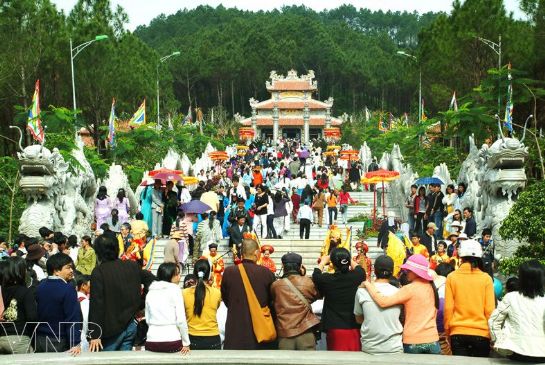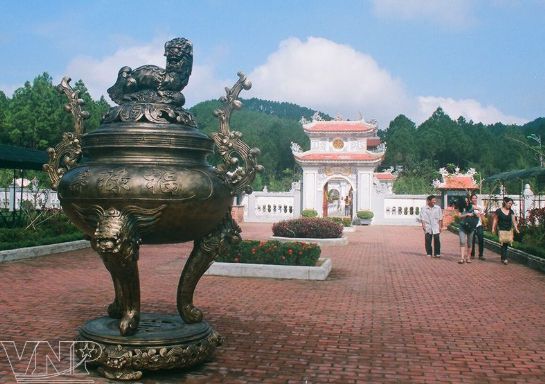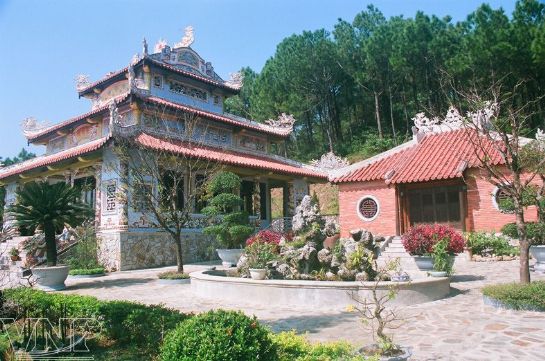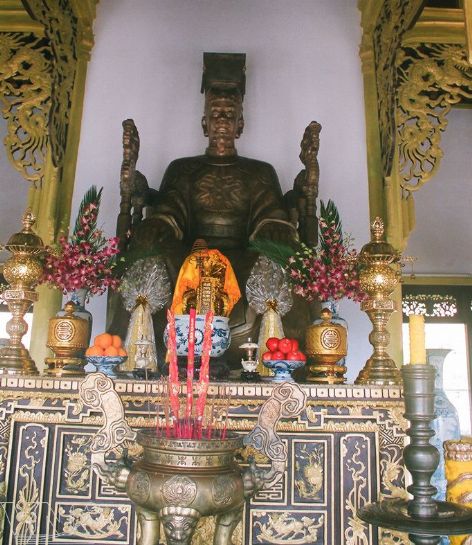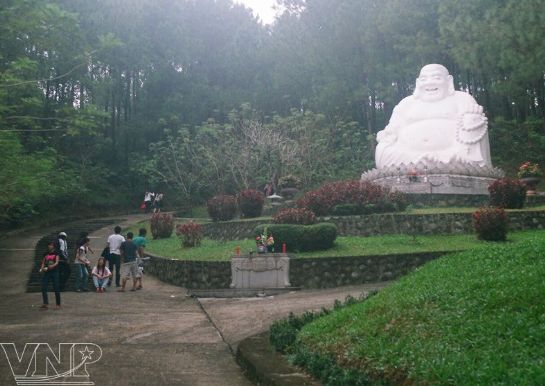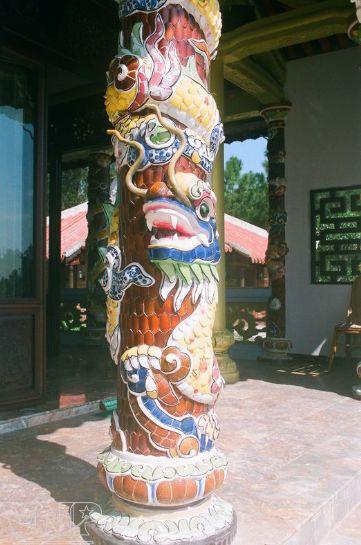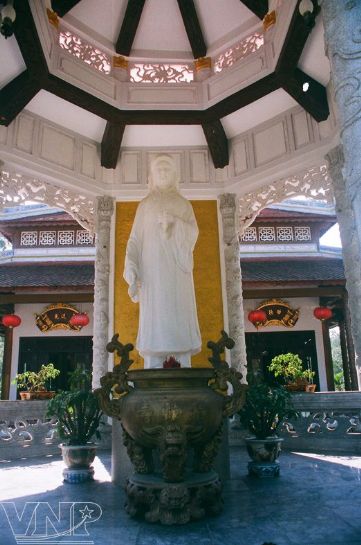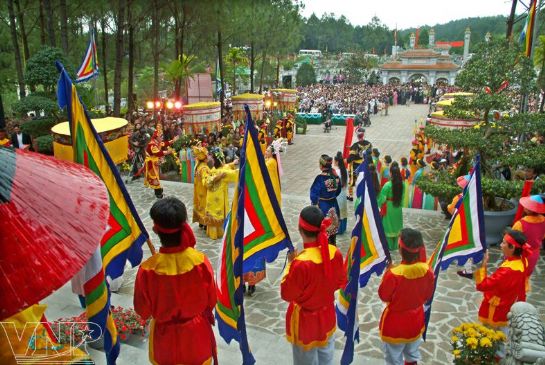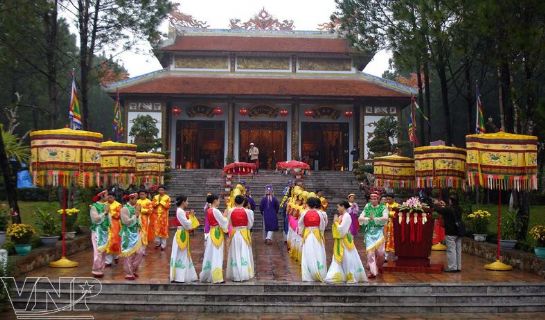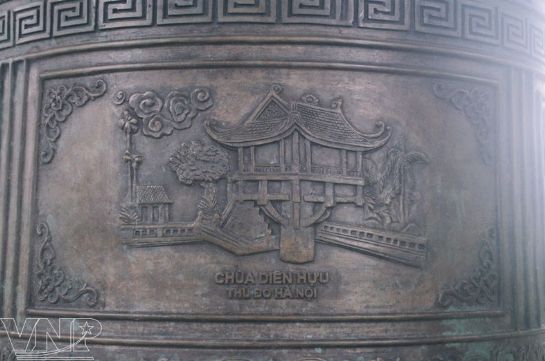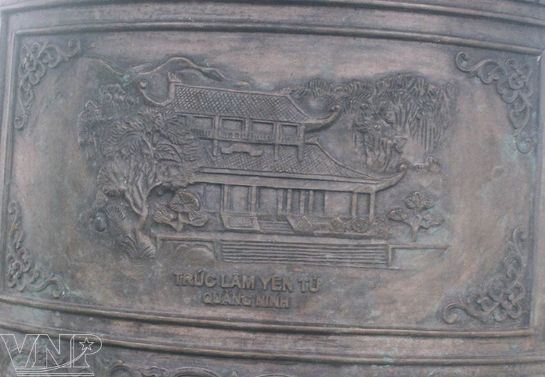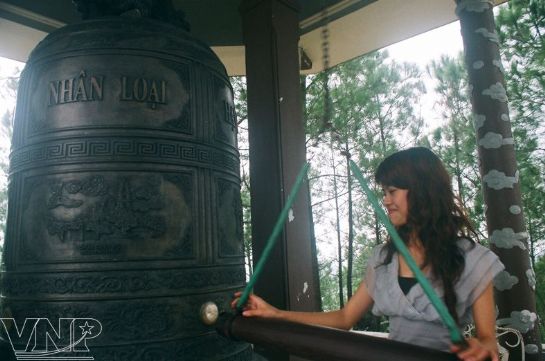From Hanoi, tourists can go in groups of twenty people in a 29-seat car with each person only paying VND600,000 for the two-way transport cost. Budget travelers can take a coach from Giap Bat coach station in Hanoi straight to Giao Xuan Village for just VND70,000 each. Along the roads leading to the eco-village, tourists can enjoy rice fields and green gardens along the National Road 21 towards the east.
“Giao Xuan Village now has 21 families who can accommodate tourists during their trip here and the homestay services create an income of some VND800,000 for each family,” said Phung Thi Thin, chairwoman of the village’s Cooporative of Community Tourism of Vietnam travel news.
‘Homestay services’ explains Phung, is the best choice for local people to live on without overexploiting the natural resources such as seashell, shrimp as well as improving the environmental condition of the village.
The village started its ‘community tourism’ in April 2006 with only some simple projects like fish sauce production, worm breeding, seashell breeding, and renovating the gardens to make temporary sleeping places for the birds living in the Xuan Thuy national park, which is some 10 kilometers from the village. “Next year, the cooperative will help develop five more houses having enough facilities to be ‘typical homestays’ so we can receive more tourists because numbers of visitors are increasing these days,” Phung adds. Giao Xuan is traditionally a farming village, located in Xuan Thuy National Park in Nam Dinh Province. The growing number of ecotourists has prompted local people to build new cement roads, reorganize their livelihoods and develop a new respect for the environment. Tran Thi Phuong, who used to be a farmer in Giao Xuan village, now has six years of experience as a tourist guide and says she loves her job because she earns more money and learns more about life. She said the village now has three main teams to provide for community tourists, offering a traditional music band, homestay houses and tourist guides. “When I decided to change my job, from farmer to a tourist guide, I and my team joined a tourism class in Hanoi. However, I soon felt happy with my new job because it helps me improve my knowledge,” Phuong told the Daily while she guides a media group from HCMC and Hanoi to view a local house making very good fish sauce in the village. On the small path leading to another house in the village, the group could smell the fish sauce. It came from the house of Mr Phung – who has spent nearly forty years making fish sauce from the local catch. Phung said his sauce, which has a strong traditional salty taste, earns him around VND200 million each year, partly thanking to the increasing number of tourists coming to the village. His yard contains nine large troughs, each filled with 1.8 tons of fish and 200 kilograms of salt. “After nearly eight months, the mixed component will give some 600 liters of fish sauce”, he said while opening one of the covers and releasing a pungent fish smell. Before saying goodbye to this old fish sauce maker, some of the group bought some products as gifts to their friends after the trip. The media group were in the village as guests of Ecolife Eco-service Company Limited, a social enterprise providing work for the community in ecotourism. It is one of a growing number of social enterprises, business models that priorities their social role over making profits, that are spreading across Vietnam. |
Tuesday, December 25, 2012
Giao Xuan Eco - Life in Nam Dinh
Just three hours drive from Hanoi, Giao Xuan Village is a familiar stop for foreigners who enjoy the countryside and prefer to stay with people in the local community rather than hang out in a luxury hotel.
Friday, December 21, 2012
Hon Tam beach in Khanh Hoa
Hon Tam Island is an island ecotourism place in the South of Nha Trang bay – Khanh Hoa province. There are many untouched features of nature along with the green tropical forest, which is green all year round.
The long and curling beach is like the mermaids showing their beauty beside the waves days and nights. The whirlpool is swayed in the coral of many colors. All are romantic illusory. Thus, Hon Tam is also chosen for the place to health recovery.
Not only visiting, visitors would also join in the sports like climbing, forest discovering, boat racing, water skiing, sail boat, water motor, badminton, volleyball, etc, and especially there is the activity of undersea discovering.
10 years ago, Hon Tam was an isolated land. Now it is becoming the eco tourism land and many people have been impressed by a trip, which is still on their mind.
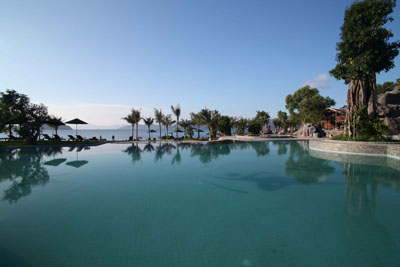 Hon Tam is named after its look, which is like the green silkworm. Hon Tam is divided into two areas, which are Section A, and Section B. Section A is a curling beach with smooth sand bank to help visitors feel the delight of seawater.
There is a big restaurant, which is capable for 300 diners at a time. Along this section, a series of 32 kiosks have been built for the group of visitors or families. After sinking in the sea, visitors would join in the water motor, water skiing, sliding on the water surface.
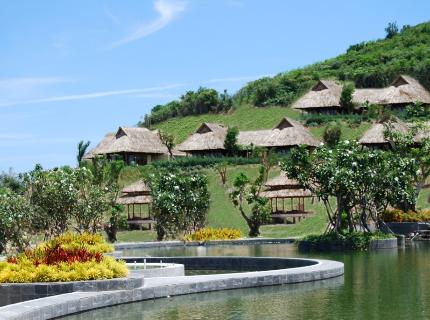 Hon Tam is quietly developed from scratch. From a neglected island, Hon Tam, has become a crowded tourism centre which attract any visitor. There are many new and strange activities, which are only special for Hon Tam
Section B is made in the form of recreational village. This is a hi-class recreational area with many suitable and beautiful features. The 10 separated villas of Asia style are divided into two luxury rooms each. All the villas face the sea and are equipped with the luxury hotel. Surrounding these villas, there are many types of flowers and local trees of Nha Trang and Vietnam.
|
Tuesday, December 18, 2012
Xung Khoeng Waterfall in Gia Lai
Located 30 km from the south-west of Pleiku City, Chu Prong District, Gia Lai Province, Xung Khoeng Waterfall with the height of 40m is a beautiful landscape in Gia Lai. From afar, tourists in Vietnam travel can hear drawling sounds of flowing water.

Xung Khoeng Waterfall- Gia Lai
Located 30 km from the south-west of Pleiku City, Chu Prong District, Gia Lai Province, Xung Khoeng Waterfall with the height of 40m is a beautiful landscape in Gia Lai. From afar, tourists in Vietnam travel news can hear drawling sounds of flowing water.On the two sides of the falls, trees and plants grow luxuriantly, and above is the high blue sky. The water makes its way into cracks in the rock to form a clear lake, surrounded by craggy walls. If you are in Gia Lai in Vietnam travel and you love the beauty of nature, Xung Khoeng waterfall should not be missed to visit! |
Lung Van - Cloudy Valley
Situated at an altitude of over 1,200 meters, Lung Van valley in Tan Lac District, Hoa Binh Province looks like a fairyland amidst white clouds. For this reason, it has another name, the cloudy valley.
 Being surrounded by Po, Trau and Tien Mountains, the valley is also considered the roof of Muong Bi fromVietnam travel news. From Hanoi, one can go along Highway 6 to Muong Khen, Tan Lac, and then turn left at a T-junction with the sign showing the way to Lung Van Valley.  Lung Van Valley attracts tourists with its Market Fair on every Tuesday and by its beautiful climate. It is cool during daytime and quilted blanket is needed at night. Two elderly locals, Bui Van Kinh, 89, and Bui Van Tam, 86, of Lung Van, are famous for their great contributions to preserving the soul of the Muong ethnic minority groups in the area. They can tell visitors all the regional rituals and several things needed in a ritual worshipping the Muong worship man. |
Monday, December 17, 2012
Phat Tich pagoga - A Buddhist cultural center with ancient sculptural
Phat Tich Pagoda - a Buddhist cultural center contains cultural and sculptural values of the Ly Dynasty. it is ideal destination for you to visit and research about Ly Dynasty.
Phat Tich (Buddha’s Trace) Pagoda, located in Phat Tich Commune, Tien Du District, Bac Ninh Province, is a cultural and historical relic in Vietnam which contains cultural and sculptural values of the Ly Dynasty. Phat Tich Pagoda, was built between the 7th and 10th centuries, and underwent several transformations throughout the years. It was first renovated during the Ly Dynasty. In 1057, King Ly Thanh Tong had a tower erected and a golden statue made. Later in the 17th century, the pagoda was enlarged. Unfortunately, the pagoda was ravaged by the war in 1947 and was rebuilt again in a simpler style in 1958. And in 1991, the pagoda has been reconstructed following ancient architectural designs. Among the remains of the pagoda is the Amitabha Buddha stone statue dating back from the 10th-11th centuries, which is considered precious object. The columns of the pagoda are decorated with intricately carved lotus flowers and orchestra with artisans playing various types of traditional musical instruments. 
The Amitabha Buddha stone statue dating back from the 10th-11th centuries
According to historical records, Phat Tich Pagoda was as an importance national pagoda, where the Kings of Ly Dynasty often come to hold the Buddhist ceremonies and pray peaceful and prosperous for the country and safety for people. This was not only a Buddhist cultural center but also the place where Buddhist monks were trained. With such special values, Phat Tich deserves as a national vestige where preserves national treasures.Phat Tich Pagoda was the place where exhibit the largest Buddha Gem statue in Viet Nam – weighing 4.5 tons and standing 3.5 meters high, engraved out of Nephrite stone block, from 16 to 22 of May 2009. The world itinerary of the Buddha Gem statute has been put together to promote world peace. Before arriving at Phat Tich Pagoda, the Buddha Gem statue had visited Da Nang, Vung Tau, Ho Chi Minh City, and Dong Thap in Viet Nam. After leaving Phat Tich Pagoda, the statue traveled to other places in the world such as USA, Taiwan etc. before being settled at the Peace Tower in Bendigo, New South Wales, Australia. In 2010, the project of renovating and restoring the Historical Cultural Vestige of Phat Tich Pagoda has almost completed which cost 75 billion VND sourced from the State budget and donations from organizations, individuals and Buddhist followers nationwide. The Phat Tich pagoda has named project to celebrate the 1000th anniversary of Thang Long – Hanoi. 
The giant Buddha statue has been placed on the Phat Tich Mountain
Now coming to Phat Tich Pagoda, visitors will have chance to contemplate a new wonder of Bac Ninh Province from Vietnam travel news. That is the statue - 27 metres high (including Buddha's throne and pedestal) and weighs more than 3,000 tonnes which considered as one of the largest stone statues in Southeast Asia and the first of its kind in Viet Nam.It has constructed since February 2007. The statue is shaped based on the model of Amitabha Buddha statue which was made of stone during the Ly Dynasty - a masterpiece of the national fine-art with skillful lines. Therefore, the making of pattern and clothing creases for the giant Buddha statue is a very painstaking work. This giant work is the achievements of tireless labor of many people. Hundreds of artisans from Ninh Van Stone Village (Ninh Binh Province) have worked hard for almost four years under the difficult construction conditions on the mountain. They had to use rail to transport tens-tonnes rocks up to the mountain to preserve the surroundings. The construction of the statue was referenced by many experts. This work was also strictly reviewed and approved. The giant Buddha statue has been placed on the Phat Tich Mountain at the 108 metres above sea-level with the inner wishes of natural potential as this is place of sacred mountain, Mount of Buddha, marking first place where the Buddhism rose up in Viet Nam. If tourists in Vietnam Travel have chance to visit Bac Ninh Province, Phat Tich Pagoda is a must-see place that should not be missed! |
Friday, November 30, 2012
Vietnamese Folk Paintings
Folk paintings includes two types of Vietnamese folk paintings, Tet (Lunar New Year Festival) paintings and worshipping paintings. They are a combination of traditional cultural values with ancient artistic methods that have been created through the labour of past generations.
| The Vietnamese people believe in ancestor worship and the deification of natural phenomena, they are reflected in the paintings. Because of their historical popularity, the folk paintings were produced in huge quantities. This high demand was met through the use of the woodblock carving printing technique, which has been practiced by the Vietnamese for several centuries. During the Ly Dynasty (12th century), there were lots of families who specialised in woodblock carving. By the end of the Tran Dynasty, they were also printing paper money. At the beginning of the Le So Dynasty, the Chinese technique of carving printing boards was chosen and improved. The History Museum and the Fine Art Museum in Hanoi still keep old printing boards as archives. During the Mac Dynasty (16th century), folk paintings developed quite extensively and were popular among the aristocracy in Thang Long. In the 18th and 19th centuries, the art of folk painting was stable and highly developed. Basing on artistic style, drawing-printing technique, and the materials used, folk paintings are classified into painting trends according to the name of their place of production. Each style of painting is different. However, in all the styles, shapes are formed based on the concept of don tuyen binh do (single line-simple designs), which uses lines to bend the coloured shapes and to make a border for the picture. Another method used is thuan tay hay mat (easy to draw and to see). With this design form, the folk paintings do not depend on the rules of perspective. The deities are big and take the upper positions, while the ordinary people are drawn on a smaller scale and the size of the animals and the natural scenery depicted depends on their relationship to the sentiment or story being expressed. These distinctive characteristics make the paintings profoundly impressive. As a result of cultural exchange, Vietnamese folk paintings in order to travel to Vietnam to contemplate them and have perserved and developed certain traditional facets. As well as the paintings have been influenced and enriched by the genius of other painting styles. One exception is Dong Ho paintings, which continue to exist unchanged during the challenges of time. » Also you like our http://minmaxvn.wordpress.com/ |
Tuesday, November 27, 2012
Best time to travel Ha Giang
The most ideal time to visit Ha Giang should be around or after the Tet Holidays, which is between February and May.
During this time, the scenery is magnificent with mountaintops hiding in the cloud and wild peach flowers blooming everywhere. Moreover, the weather during the Tet holidays is very comfortable with little rain and cool air, so that tourists in Vietnam tours do not have to carry raincoats or umbrellas with them.
There are also a lot of unique and attractive festivals to celebrate the New Year during this time. Hence, visitors with Vietnam travel guide can have a chance to know more about the ethnic culture in Ha Giang and enjoy the festive atmosphere of various ethnic groups. Lastly, as this is the dry season and the routes to Ha Giang mostly go along the side of mountains, the roads are much safer for trip.
Beautiful and Delicious Đà Lạt
There’s a wonderful place nestled in the central highlands immune to the hot and humid tropical climate of Vietnam, called Đà Lạt, the city of eternal spring. Here the temperate climate is a marked contrast to the rest of central and southern Vietnam and averages in the highs 70′s F compared with the 90-100F of other parts of the central and south lands. It reminds us of Seattle and the great Northwest with lush green vegetation and beautiful flowers everywhere. Mountainous lakes and many waterfalls dot the surrounding countryside around Đà Lạt and make for nice day trips upon entering or leaving the city.
We spent 3 days here breathing in the cool crisp summer air, a welcomed departure from the smog polluted air of Saigon. It was the first night since arriving in Vietnam that we weren’t awaken by the incessant horns of motorbikes and taxis, which was equally refreshing. Originally built as a resort town during the French colonization, Đà Lạt is a small urban town of 200,000 compared with the 10 million of Saigon, and still remains a popular vacation and honeymoon destination for the Vietnamese.

Aside from the beautiful scenery. We made several trips the central market of Đà Lạt, a vital hub of the city and a street photographer’s dream. Inside the market are many dry goods stalls tightly packed together, but surrounding the market on all sides is abuzz with activity and interesting food scenes. The narrow side roads around the market doubles as a market stall for vendors and route of transportation for bicycles, motorbikes, cars, and pedestrian shoppers alike. Watch your step as you might just run into a fresh load of durian freshly plucked from the trees and brought to market by motorbike.

You will find vendors of all ages, from stout wrinkled grandmotherly types to lithe teens flexing huge bundles of hot from the oven banh mi on their hips as easily as if they were carrying their newborn. Since there’s traffic on all four side streets around the market, the more mobile vendors will constantly move their wares, either carrying this load of banh mi like this girl or hitching it to a bamboo stick.


You can find everything from fresh durian, rambutan, and pomelo to fresh fish and meats. Unlike here in the States, Vietnamese shop for the day not the week. There are many families that don’t even have refrigeration to stock up so daily trips to the market for produce is common place.

Above the market on the second level are many food stalls, but by late afternoon as the market closes, the front entrance to the market comes alive with street food vendors of all varieties. Since the temperature tends to be cool in the evenings, hot chicken congee with appropriate offals as well as hearty beef stews, bo kho are on the menu to warm the soul. Grilled meat on sticks and betel wrapped beef skewers tinge the cool fresh air with it’s smoky salivating aroma. It’s a fantastic way to spend an afternoon immersed in the sights, sounds, and smells of Đà Lạt with the locals.

Thursday, November 22, 2012
Ca Na Beach
Ca Na beach is about 32km away from Phan Rang city. Visiting Ca Na beach, travelers will not only have chance to enjoy the fascinating beach with, but also there are other types of tourism such as ecotourism, cultural and cuisine tourism.
Ca Na attracts visitors for its magnificent scenery with clear blue sea covered by white sandy beach and mountain on its back. The clean and cool atmosphere at Ca Na, plus the stunning beach will satisfy even the most demanding tourists.


Ca Na is also well-known for many cultural attractions. With the cultural features of many Cham people, who still make their home here, and still preserve many traditional elements of their culture. Hence, visitors can learn more about the history of Champa Kingdom and understand more about the culture of Cham people in Vietnam.
Moreover,the beach is also a great choice for cuisine tours because there are diverse kinds of fresh and delicious dishes. Staying there, you will have chance to enjoy the tastiest and freshest specialties.
Wednesday, November 21, 2012
The night at Dao Village
In the Nam Choong village of Xin Man Commune, Ha Giang Province, Vietnam, tourists can do just that as they can easily find a cozy homestay for the night and enjoy the hot spring that runs through the village during the day as they experience the daily routines of Dao people.
Just spending one night with a Dao minority family is a great experience for tourists.
In the Nam Choong village of Xin Man Commune, Ha Giang Province, tourists can do just that as they can easily find a cozy homestay for the night and enjoy the hot spring that runs through the village during the day as they experience the daily routines of Dao people.
Xin Man Commune is located in the north-west area of Ha Giang Province but tourists can reach it from the city of Ha Giang or Lao Cai.
Nam Choong village is special not only thanks to the hot spring, but also because it’s the living place of Dao Ao Dai and its villagers still keep the old traditions alive on a daily basis.

The bridge leading to the Dao’s locality

The hosts will serve lunch and dinner according to visitor’s request. Normally meals will include chicken, pork, buffalo, fish and vegetable dishes - Photos: Pham Thai
Hai Ba Trung Temple Festival in Hanoi
The Hai Ba Trung (Trung Sisters) Temple Festival is held annually on lunar January 6 in Me Linh Commune, Me Linh District, Hanoi. It is the birthplace of the two sisters Trung Trac and Trung Nhi, two famous Vietnamese heroines who rode elephants to lead their troops to defeat the foreign invaders. Here they proclaimed themselves the new empresses after gaining independence for the country in the early years of Vietnam (40-43AD).
The Festival opens with the procession of the king’s palanquins, fighting-elephants and offerings from the Ha Loi Communal House to the ancient complex of Hai Ba Trung Temple. The procession is held with jubilance and excitement with colourful flags, drumbeats, gongs and musical sounds performed by an octet. The respected elders in the village are selected to beat drums and strong men and beautiful girls carry the two palanquins during the procession. On both sides of the village road, the villagers display their offerings to welcome the procession.
The Festival also includes many cultural activities, such as traditional dances, wrestling and folk games of swinging and earthen pot-beating.
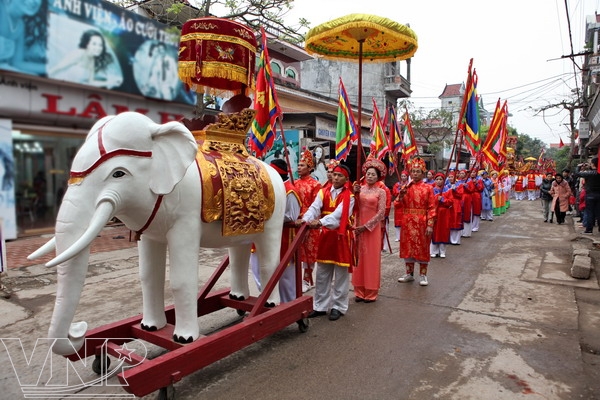 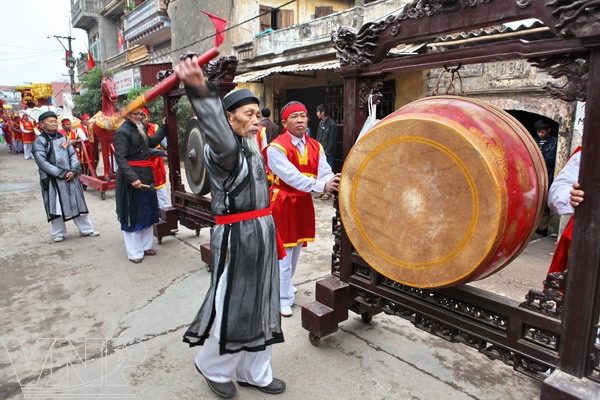 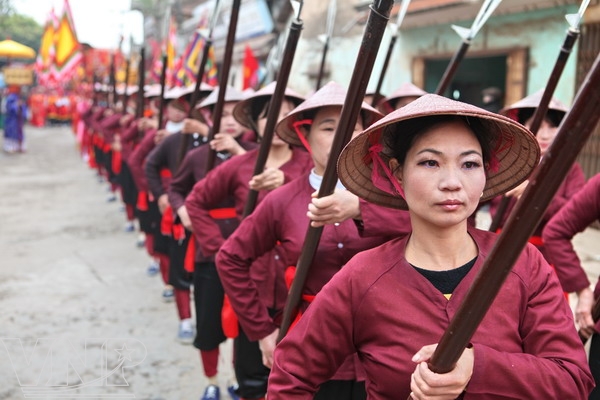
Girls play the role of soldiers of the Trung Sisters
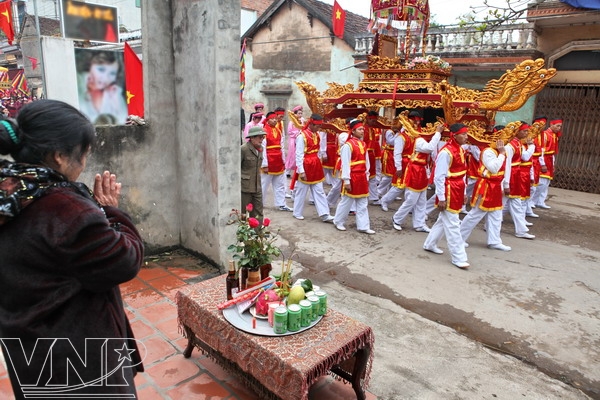 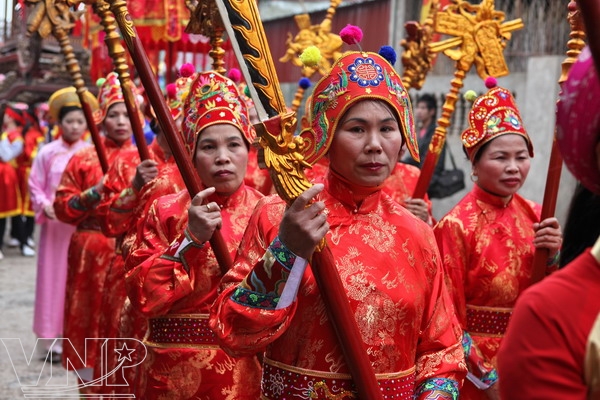 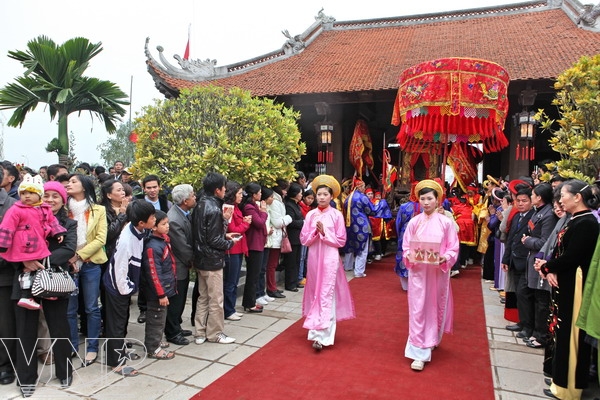 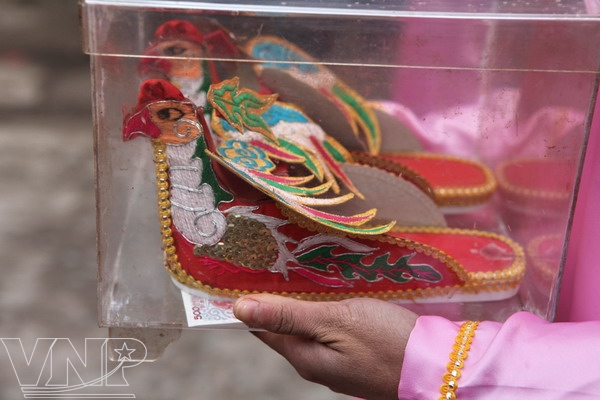 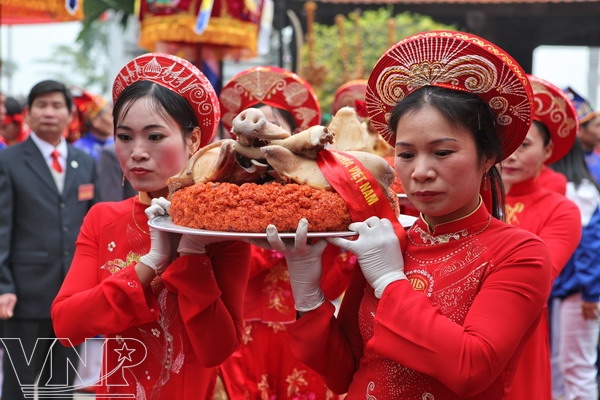 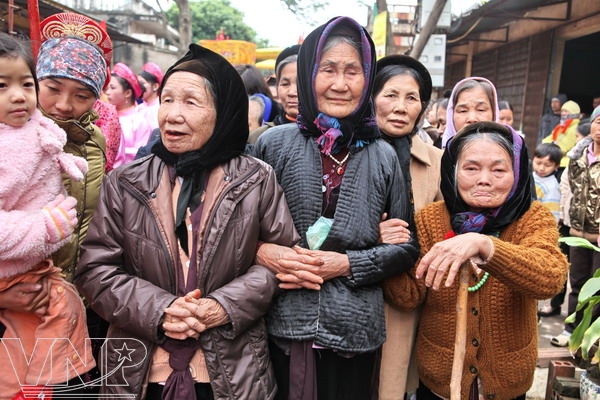 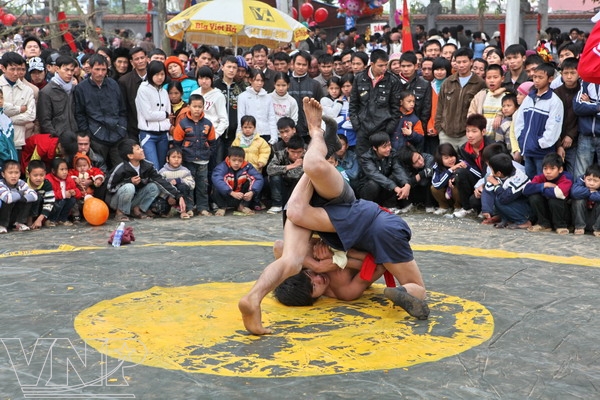 |
The Festival is of great spiritual and religious significance. It is a cultural event to educate young people about the patriotic tradition and to salute the country and its heroic women.
Thursday, November 15, 2012
Huyen Tran Cultunal Centre - a Sacred Spiritual Attraction
Visitors to Huyen Tran Cultural Centre in Hue city will have an opportunity to contemplate the wholesome environment shaded by green pine trees and surrounding forests and mountains, visit the temples and shrines for worshiping, do research on Buddhism, compose poems or relax and absorb the magnificent surroundings. The entire complex is located amid a grandiose natural setting that highlights the value of the cultural and art works and their spiritual impression.
Situated in the temple dedicated to King Tran Nhan Tong, who is considered the master of the Truc Lam Buddhist sect in Vietnam, is a statue of his Royal Highness, made of pure copper, standing 3m high and weighing 2 tonnes. It is cast identically to the original statue of the Tran Kings for worship in Nam Dinh Province. In front of King Tran Nhan Tong's shrine and along the stairway leading to it, are a pair of stone dragons made in the style of the Tran Dynasty (1225-1400). In the yard and along the staircases there are statues of elephants, horses, dragons and lions, believed to be spirits that safeguard the king's after world, making it impressive with a quiet and solemn beauty.
The temple dedicated to Princess Huyen Tran was built with the architecture of Hue pagodas. The entire structure lies on a horizontal axis. In front of the first shrine there are three copper bas-reliefs engraved with scenes from the three regions of the country. In the main chamber, there is a copper statue of Princess Huyen Tran, 2.37m high and 1.5 tonnes in weight, which was cast by famous artisans from Hue. Besides the temples, in the open and spacious space there is an octagonal shaped house where stands a statue of the Nun Huong Trang and a courtyard with a statue of Mitreya (Buddha). After climbing on 246 stone stairs, visitors will arrive at the top of Ngu Phong Mountain, 108 m high, where there is a bell tower named Hoa Binh, (peace) housing a bell made of pure copper, 2.16m high and 1.6 tonnes in weight, and carved with eight words, literally, "For a peaceful world, for a happy mankind", together with pictures of four pagodas typical for the country, namely Giac Lam Pagoda (in Ho Chi Minh City), Thien Mu Pagoda (Hue), Dien Huu Pagoda (Hanoi) and Truc Lam-Yen Tu Pagoda (Quang Ninh). Huyen Tran Cultural Centre is one of the tourist sites that provide visitors a sense of returning to the root of the country's glorious history to pay homage to people who had merits in building the country. |
These Greatest Street Foods Of The Hanoi Capital
On these beginning days of the autumn, these street foods are always the first choice of the youth and the tourists. Guests will have the opportunity to experience feelings of eating outside in the cool air.
| 1.Pho Pho heads the list of the most famous dishes of Hanoi in particular and Vietnam in general. This popular dish can be seen everywhere from the sidewalk to the restaurant where you can catch sight of the crowd gathered around the table and chairs plastic, enjoy a hot bowl of Pho. 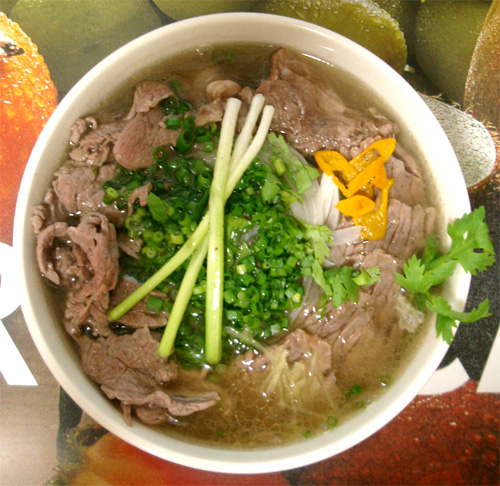 Making eaters feel charming flavor of the dish immediately is the secret of this profession. Smooth noodle cake is made from rice. If it is beef noodle , broth must be used from beef bones, pork bones; and chicken noodle uses mainly from the pork bone or chicken bone. Pho is not only cheap but also tasty, and it is always sold 24/24. Famous address: Pho Thin, 13 Lo Duc 2.Nem Thanks to special flavor, “ nem cuon” always attracts foreigner when they visit Viet Nam. Besides traditional dishes, Hanoi has created many kinds of new “ nem cuon” such as “nem cuon” with shrimp and other fresh vegetables 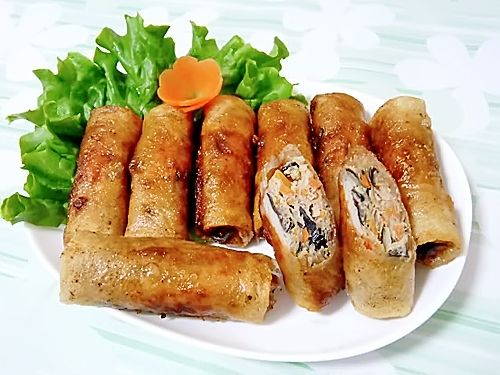 Guests can enjoy these delicious cuisines at Nem Vuong Pho Co restaurant ( 58 Dao Duy Tu) or To Tich street located in Hanoi Old Quarter, near Hoan Kiem Lake. 3. Cha ca Hanoi people consider “ cha ca” as a special dish to the extent has a street named “ cha ca”. There has a famous restaurant- Cha Ca La Vong in this street. Instead of visiting Cha ca street, visitors can also find the Duong Thanh where there are many restaurants serving this cuisine with delicious flavor. 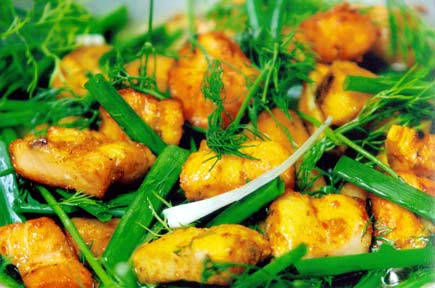 4. Chicken legs grilling and ga tan Ly Van Phuc is a famous address with the name “ Pho Ga”. Chicken legs, chicken wings, potato and bread here is scanned with honey before grilling and guests can eat it with chili sauce and cucumber. I am sure that this cuisine will bring you great taste. 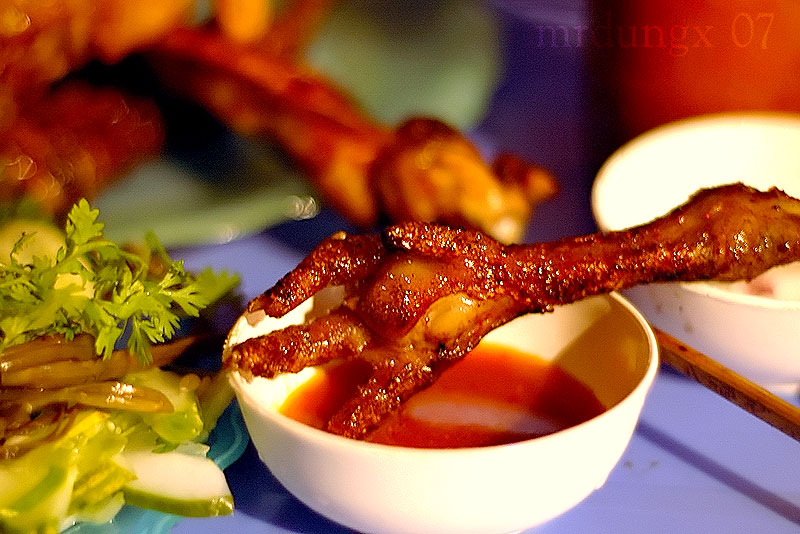 In addition, “ ga tan” is also the best food to nourish your health and you should try once at Tong Duy Tan street. 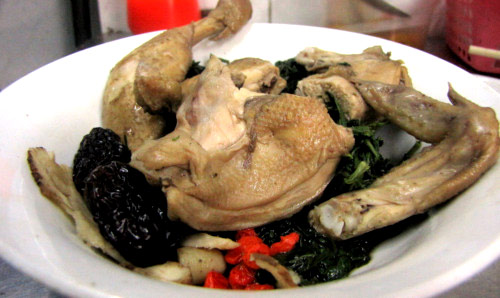 |
The Fairy Smooth Hair Of Ta Gu Waterfall
Ta Gu Waterfall is one of famous tourism destinations in Nha Trang, located in Son Hiep commune, Khanh Son district, Khanh Hoa province. From the centre of Khanh Son district following the opposite direction 15 km further, there is Son Hiep commune. Reach there, visitors can easily recognize the majestic mountains which are about 1,300 m higher than sea level, the pure air in the mountainous region.
Formerly, the waterfall was named Nga waterfall. After that, people changed its name into Ta Gu, the name of the spring flowing to the waterfall according to Vietnam travel news.
There are two myths about the waterfall formation. Anciently, there were many pythons in this forest; one was as big as a-hundred-year-old To Hap tree. In a morning of dry season, a flock of pythons went to the top finding food. On the way, they met a small elephant losing its mother which was bewildered. Immediately, the leading python run to hurl the elephant down. The elephant and the pythons fought fiercely. Finally, both two animals fell into the abyss. When the mother elephant came back finding her child dead, she stood on the mountain top crying nights and days, then she turned to rock. Two flows of the mother’s teardrop became two flows of waterfall.
According to another myth, Ta Gu anciently was a transparent, pure stream. Every year in spring, animals bustlingly took part in a festival. Fascinated by the beautiful stream, the fairies from the sky usually flied down bathing in the stream then went to the mountain top spreading their hair feeling the wind withVietnam travel news. One day, the smallest fairy busies herself with playing, forgot the restricted time so she had to stay at the human world, finally she became Ta Gu Waterfall.
However, in both two myths, Ta Gu waterfall was beautiful, mysterious, majestic with two flows rumblingly pouring from the height of 30-40m, and blue lake which is about 1km wide.
Especially, despites of being one of the most famous tourism destinations in Nha Trang, the waterfall still remains its wild scenery, being an ideal destination for visitors who are keen on adventure.
The charm of the waterfall is created by not only the beautiful landscape but also forest and stream crossing travel during the way to the waterfall. It’s so interesting that after reaching the waterfall, the adventure still continues. Firstly, people must hold the tree roots to go down, pass a stream, then meet a deep and large lake. After that, they continue to cross the slippery stream in the top right, crowd to the canopies of wild plants keeping moving to the bottom of the waterfall.
There is an extremely excited feeling when stopping near straight cliff, facing with the wonderful waterfall which is rumblingly flowing. All tiredness seems to be left out in the cold water of the wide lake in the waterfall bottom. It will be more interesting to hold a camping party among the mountainous area to connect members in group.
Subscribe to:
Comments (Atom)


